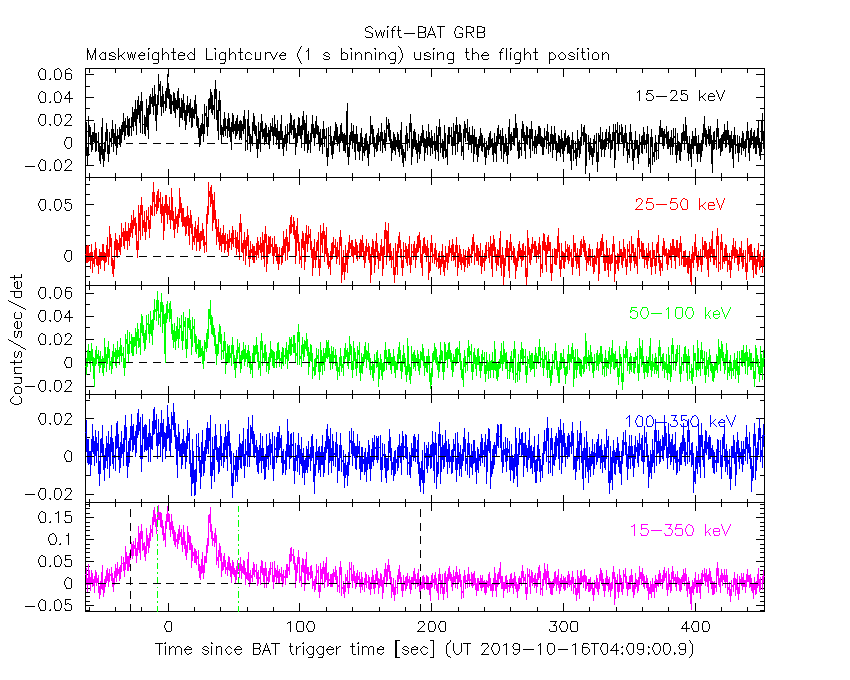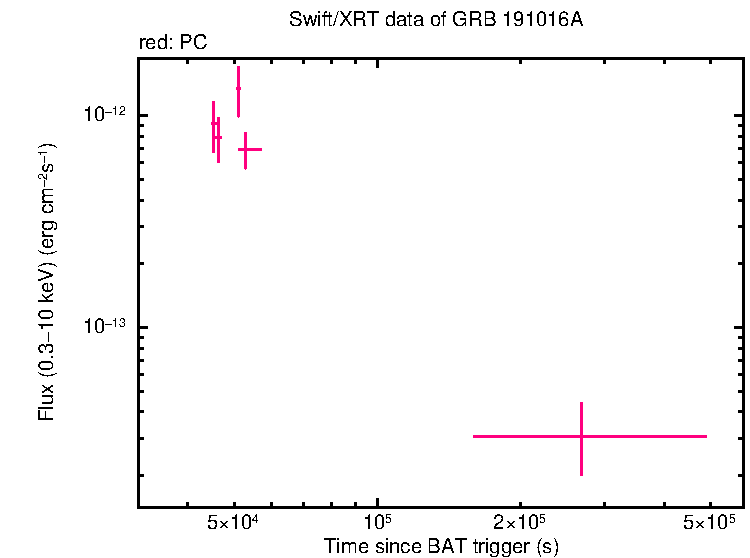
J.D. Gropp (PSU), K.L. Page (U. Leicester) and M.H. Siegel (PSU) for the Swift team
At 04:09:00 UT, the Swift Burst Alert Telescope (BAT) triggered and located GRB 191016A (trigger=929744) (Gropp et al. GCN Circ. 26008). Swift did not immediately slew due to an observing constraint. At the time of the trigger, the initial BAT position was 162° from the Sun (11.3 hours West) and 19° from the 95%-illuminated Moon. Table 1 contains the best reported positions from Swift.
Watson et al. (GCN Circ. 26010) reported the position from COATLI for the optical afterglow of this GRB. Siegel and Gropp (GCN Circ. 26024) reported the detection with UVOT of an optical afterglow. Table 2 is a summary of GCN Circulars about this GRB from observatories other than Swift.
Standard analysis products for this burst are available at https://gcn.gsfc.nasa.gov/swift_gnd_ana.html.
As reported by Barthelmy et al. (GCN Circ. 26012),
the BAT ground-calculated position is RA, Dec = 30.268, 24.508 deg which is RA(J2000) = 0
The mask weighted light curve (Figure 1) shows two overlapping pulses.
Overall structure starts at ~ T-40 s and lasts till ~ T+420 s.
The two peaks occur at ~ T-10 s and ~ T+35 s, respectively.
The time-averaged spectrum from T-42.82 to T+422.61 s is best fit by a simple power-law model.
The power law index of the time-averaged spectrum is 1.55 ± 0.09.
The fluence in the 15-150 keV band is 6.5 ± 0.4 x 1
The results of the batgrbproduct analysis are available at https://gcn.gsfc.nasa.gov/notices_s/929744/BA/.
Analysis of the initial XRT data was reported by Page et al. (GCN Circ. 26026).
The light curve (Figure 2) can be modelled with a power-law decay with a decay index of α=1.8 (+1.5, -0.5).
A spectrum formed from the PC mode data can be fitted with an absorbed
power-law with a photon spectral index of 1.9 (+0.5, -0.4). The
best-fitting absorption column is 1.4 (+1.7, -0.4) x 1
The Swift/UVOT began settled observations of the field of GRB 191016A 45 ks after the BAT trigger
(Siegel and Gropp GCN Circ. 26024).
A source is detected consistent with the XRT position and the optical source reported by Watson et al. (GCN Circ. 26010, 26015), Zheng and Filippenko (GCN Circ. 26011), Hu et al. (GCN Circ. 26017), Kim et al. (GCN Circ. 26018) and Toma et al. (GCN Circ. 26019).
Table 3 gives preliminary
magnitudes using the UVOT photometric system
(Breeveld et al. 2011, AIP Conf. Proc., 1358, 373).
No correction has been made for the expected extinction in the Milky Way
corresponding to a reddening of

Figure 1. The BAT
mask-weighted light curve in the four individual and total
energy bands. The units are counts

Figure 2. The XRT light curve.
Any data from a crosshatched region are not included in the fit.
| RA (J2000) | Dec (J2000) | Error | Note | Reference |
|---|---|---|---|---|
| 0 |
+24°30'35.7" | 0.5" | UVOT-refined | Siegel and Gropp GCN Circ. 26024 |
| 0 |
+24°30'35.6" | 1.9" | XRT-final | UKSSDC |
| 0 |
+24°30'35.6" | 1.9" | XRT | Page et al. GCN Circ. 26026 |
| 0 |
+24°30'30.4" | 1.5' | BAT-refined | Barthelmy et al. GCN Circ. 26012 |
| Band | Authors | GCN Circ. | Subject | Observatory | Notes |
|---|---|---|---|---|---|
| Optical | Lipunov et al. | 26009 | Swift GRB191016.17: Global MASTER-Net observations report |
MASTER | |
| Optical | Watson et al. | 26010 | COATLI Optical Observations and Detection of the Afterglow |
COATLI | detection |
| Optical | Zheng and Filippenko | 26011 | KAIT Optical Afterglow Confirmation | KAIT | detection |
| Optical | Jelinek and Strobl | 26013 | Optical limit by Ondrejov D50 | D50 | upper limits |
| Optical | Watson et al. | 26015 | RATIR Optical and NIR Observations | RATIR | detection |
| Optical | Hu et al. | 26017 | early time BOOTES Network and follow-up 1.5m OSN optical observations |
BOOTES | detection |
| Optical | Kim et al. | 26018 | AZT-20 (Assy observatory) optical photometry |
detection | |
| Optical | Toma et al. | 26019 | MITSuME Okayama optical observation | MITSuME Okayama | detection |
| Optical | Melandri et al. | 26028 | REM optical observations | REM | detection |
| Optical | Schady and Bolmer | 26176 | GROND observations | GROND | detection |
| Filter | Exp(s) | Mag | ||
|---|---|---|---|---|
| white | 45023 | 46878 | 1822 | 21.09±0.17 |
| white | 50812 | 52638 | 1794 | 21.21±0.19 |
| white | 56420 | 56938 | 506 | >21.23 |
Table 3. UVOT observations reported by Siegel and Gropp (GCN Circ. 26024). The start and stop times of the exposures are given in seconds since the BAT trigger. The preliminary detections and 3-σ upper limits are given. No correction has been made for extinction in the Milky Way.
November 6, 2019